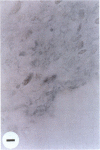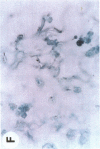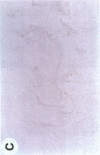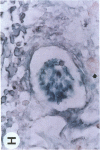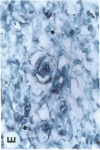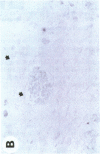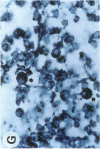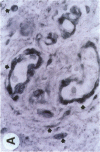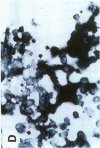Abstract
Somatostatin (Sms) and its agonist analogues inhibit the secretory activities of endocrine and neural cells. Recent studies have suggested that Sms has significant immunomodulatory properties. In this study, we examine the effects of two Sms octapeptide analogues on the inflammatory reaction in vivo. BIM 23014 (Somatulin) and Sandostatin were administered to male Sprague-Dawley rats subject to carrageenin-induced aseptic inflammation, at doses of 2-10 micrograms/rat, given either systemically or locally. Animals were killed 7 h after the induction of the inflammation, and the inflammatory exudates were aspirated and quantitated in terms of volume and leukocyte concentration. Sms analogues, administered via either route, significantly reduced the volume and the leukocyte concentration of the exudate in a time- and dose-dependent fashion. In corroboration of these, immunohistochemical evaluation of the levels of local inflammatory mediators, such as immunoreactive (Ir) TNF-alpha, Irsubstance P, and Ircorticotropin-releasing hormone, was inhibited significantly by Sms analogue treatment. These findings suggest that Sms analogues have significant antiinflammatory effects in vivo, associated with suppression of proinflammatory cytokines and neuropeptides. Furthermore, these data suggest that Sms agonists may be useful in the control of inflammatory reaction.
Full text
PDF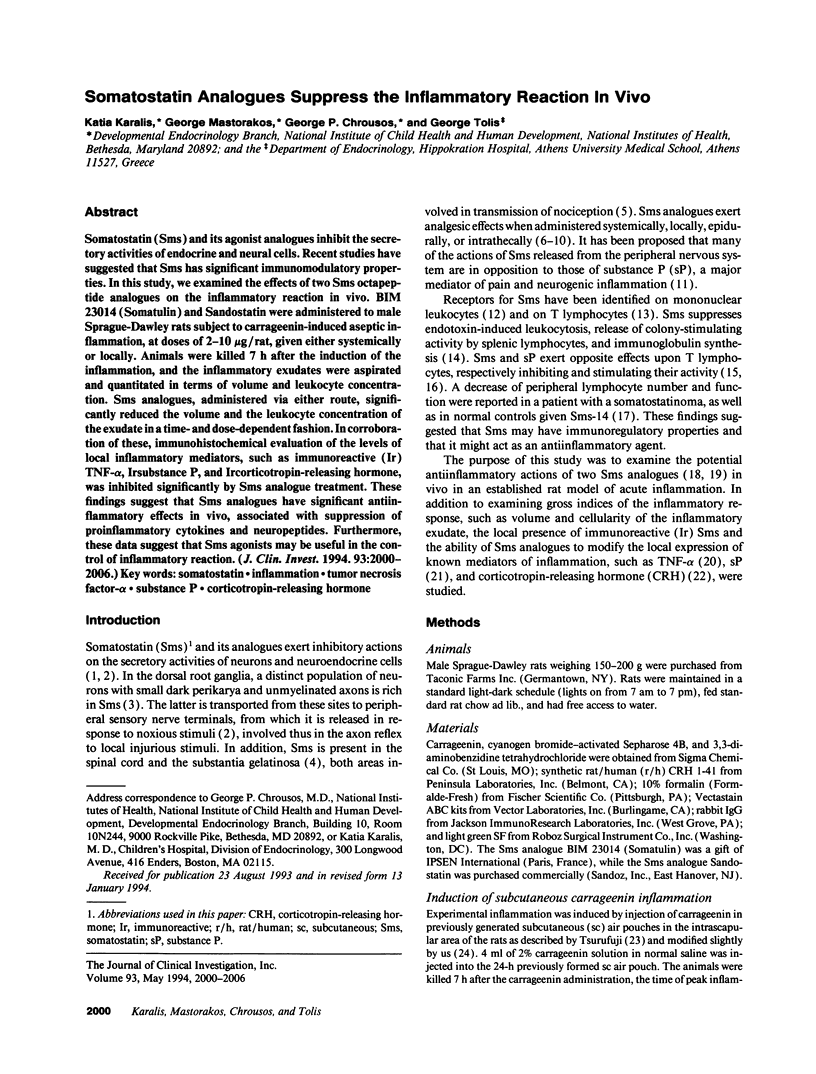
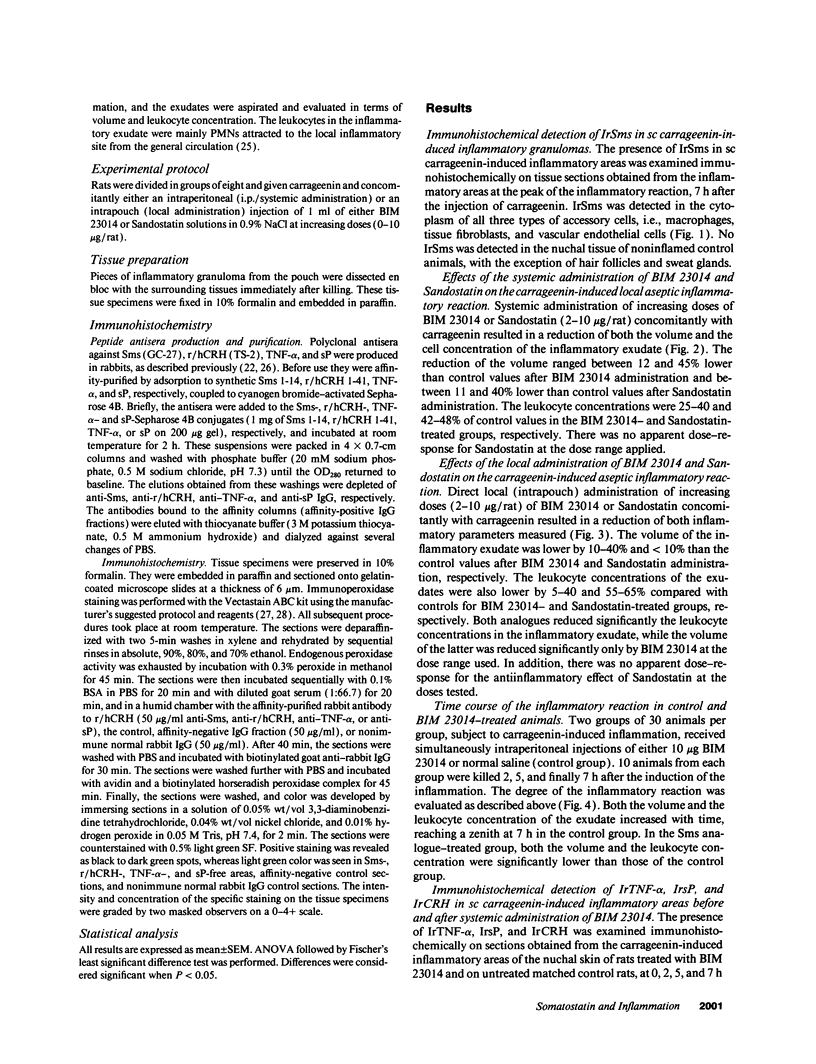
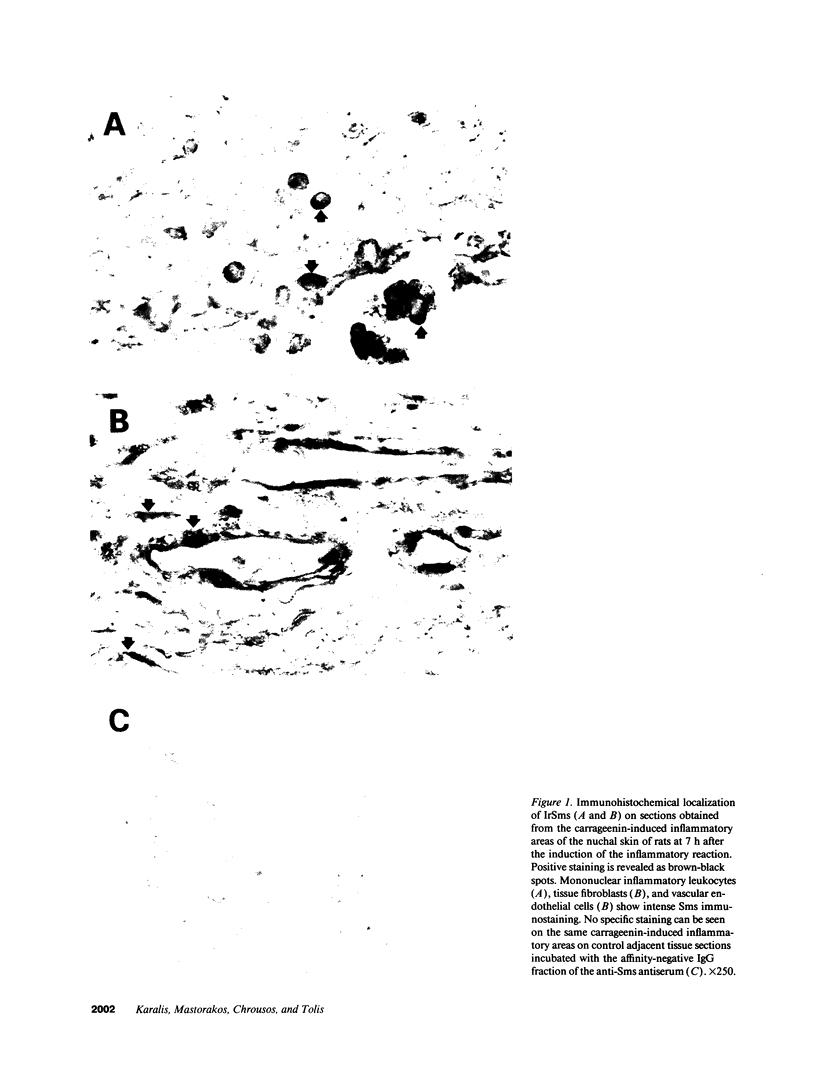
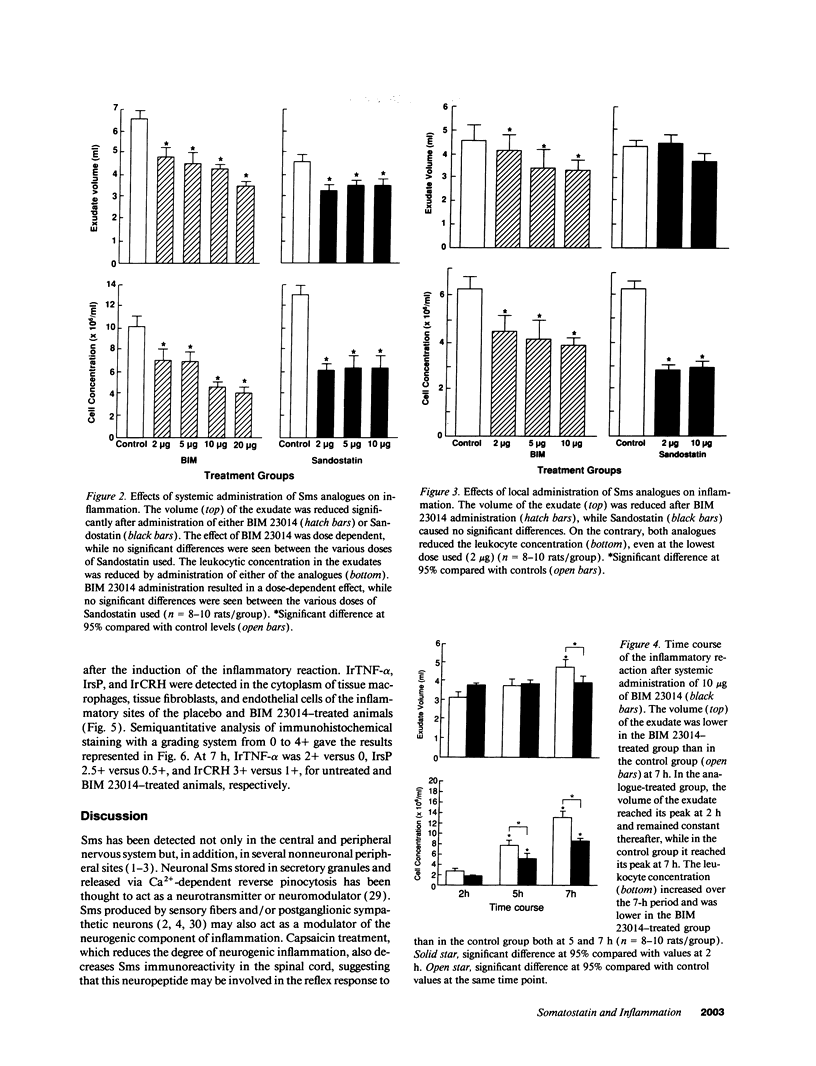
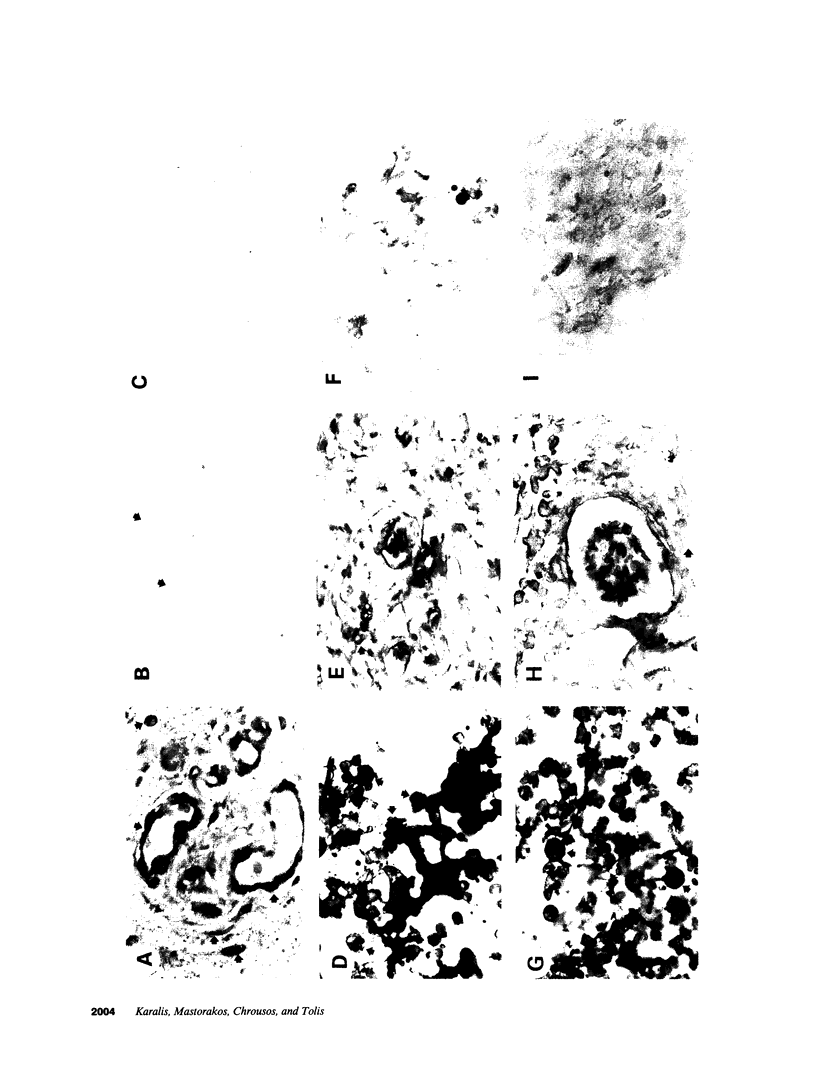
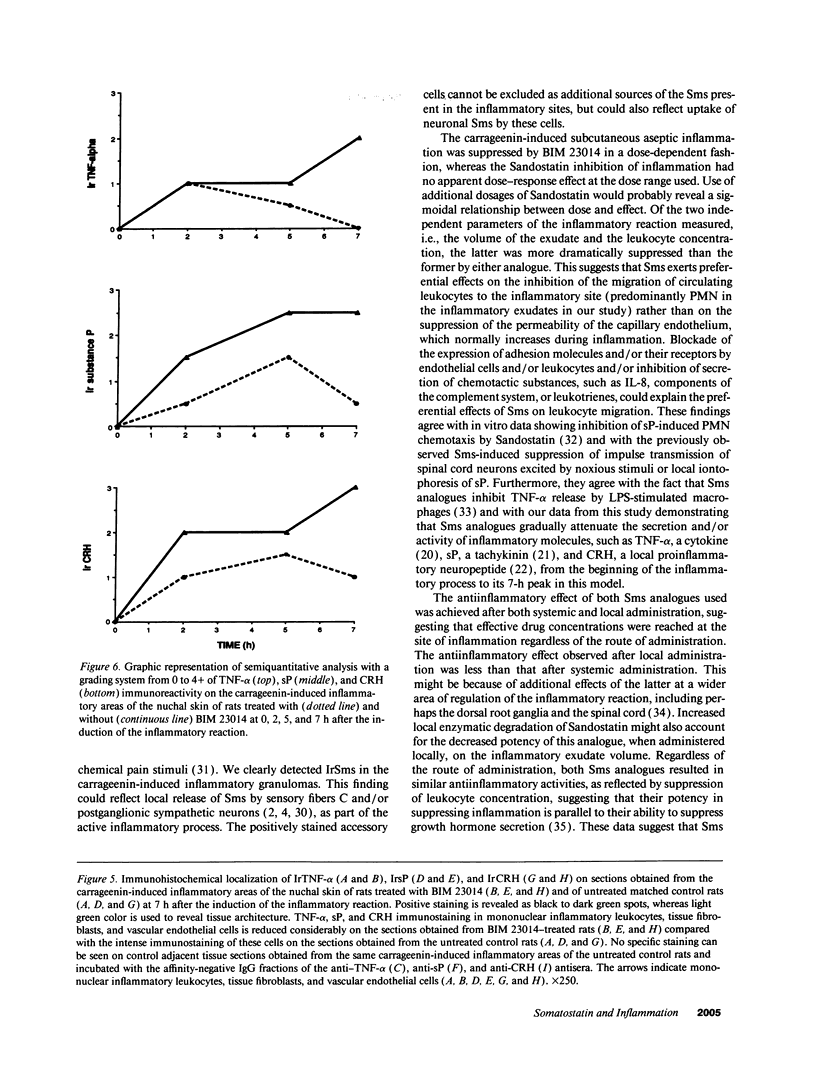

Images in this article
Selected References
These references are in PubMed. This may not be the complete list of references from this article.
- Bauer W., Briner U., Doepfner W., Haller R., Huguenin R., Marbach P., Petcher T. J., Pless SMS 201-995: a very potent and selective octapeptide analogue of somatostatin with prolonged action. Life Sci. 1982 Sep 13;31(11):1133–1140. doi: 10.1016/0024-3205(82)90087-x. [DOI] [PubMed] [Google Scholar]
- Bermudez L. E., Wu M., Young L. S. Effect of stress-related hormones on macrophage receptors and response to tumor necrosis factor. Lymphokine Res. 1990 Summer;9(2):137–145. [PubMed] [Google Scholar]
- Bernardini R., Kamilaris T. C., Calogero A. E., Johnson E. O., Gomez M. T., Gold P. W., Chrousos G. P. Interactions between tumor necrosis factor-alpha, hypothalamic corticotropin-releasing hormone, and adrenocorticotropin secretion in the rat. Endocrinology. 1990 Jun;126(6):2876–2881. doi: 10.1210/endo-126-6-2876. [DOI] [PubMed] [Google Scholar]
- Beutler B. A., Milsark I. W., Cerami A. Cachectin/tumor necrosis factor: production, distribution, and metabolic fate in vivo. J Immunol. 1985 Dec;135(6):3972–3977. [PubMed] [Google Scholar]
- Bhathena S. J., Louie J., Schechter G. P., Redman R. S., Wahl L., Recant L. Identification of human mononuclear leukocytes bearing receptors for somatostatin and glucagon. Diabetes. 1981 Feb;30(2):127–131. doi: 10.2337/diab.30.2.127. [DOI] [PubMed] [Google Scholar]
- Bogden A. E., Taylor J. E., Moreau J. P., Coy D. H., LePage D. J. Response of human lung tumor xenografts to treatment with a somatostatin analogue (Somatuline). Cancer Res. 1990 Jul 15;50(14):4360–4365. [PubMed] [Google Scholar]
- Boumpas D. T., Chrousos G. P., Wilder R. L., Cupps T. R., Balow J. E. Glucocorticoid therapy for immune-mediated diseases: basic and clinical correlates. Ann Intern Med. 1993 Dec 15;119(12):1198–1208. doi: 10.7326/0003-4819-119-12-199312150-00007. [DOI] [PubMed] [Google Scholar]
- Caleri D., Marabini S., Panconesi A., Pietrini U. A pharmacological approach to the analgesizing mechanism of somatostatin in cluster headache. Ric Clin Lab. 1987 Apr-Jun;17(2):155–162. [PubMed] [Google Scholar]
- Chan A. W., Williams G., MacFarlane I. A., Bowsher D. Octreotide, a long-acting somatostatin analogue, in diabetic neuropathic pain. Horm Res. 1991;36(1-2):86–87. doi: 10.1159/000182119. [DOI] [PubMed] [Google Scholar]
- Chrubasik J. Somatostatin. Eine Ubersicht. Anasth Intensivther Notfallmed. 1985 Aug;20(4):165–170. [PubMed] [Google Scholar]
- Flower R., Gryglewski R., Herbaczyńska-Cedro K., Vane J. R. Effects of anti-inflammatory drugs on prostaglandin biosynthesis. Nat New Biol. 1972 Jul 26;238(82):104–106. doi: 10.1038/newbio238104a0. [DOI] [PubMed] [Google Scholar]
- Gazelius B., Brodin E., Olgart L., Panopoulos P. Evidence that substance P is a mediator of antidromic vasodilatation using somatostatin as a release inhibitor. Acta Physiol Scand. 1981 Oct;113(2):155–159. doi: 10.1111/j.1748-1716.1981.tb06876.x. [DOI] [PubMed] [Google Scholar]
- Goetzl E. J., Chernov T., Renold F., Payan D. G. Neuropeptide regulation of the expression of immediate hypersensitivity. J Immunol. 1985 Aug;135(2 Suppl):802s–805s. [PubMed] [Google Scholar]
- Hinterberger W., Cerny C., Kinast H., Pointner H., Tragl K. H. Somatostatin reduces the release of colony-stimulating activity (CSA) from PHA-activated mouse spleen lymphocytes. Experientia. 1978 Jul 15;34(7):860–862. doi: 10.1007/BF01939667. [DOI] [PubMed] [Google Scholar]
- Hsu S. M., Raine L., Fanger H. A comparative study of the peroxidase-antiperoxidase method and an avidin-biotin complex method for studying polypeptide hormones with radioimmunoassay antibodies. Am J Clin Pathol. 1981 May;75(5):734–738. doi: 10.1093/ajcp/75.5.734. [DOI] [PubMed] [Google Scholar]
- Hsu S. M., Raine L., Fanger H. Use of avidin-biotin-peroxidase complex (ABC) in immunoperoxidase techniques: a comparison between ABC and unlabeled antibody (PAP) procedures. J Histochem Cytochem. 1981 Apr;29(4):577–580. doi: 10.1177/29.4.6166661. [DOI] [PubMed] [Google Scholar]
- Hökfelt T., Elfvin L. G., Elde R., Schultzberg M., Goldstein M., Luft R. Occurrence of somatostatin-like immunoreactivity in some peripheral sympathetic noradrenergic neurons. Proc Natl Acad Sci U S A. 1977 Aug;74(8):3587–3591. doi: 10.1073/pnas.74.8.3587. [DOI] [PMC free article] [PubMed] [Google Scholar]
- Hökfelt T., Johansson O., Ljungdahl A., Lundberg J. M., Schultzberg M. Peptidergic neurones. Nature. 1980 Apr 10;284(5756):515–521. doi: 10.1038/284515a0. [DOI] [PubMed] [Google Scholar]
- Karalis K., Sano H., Redwine J., Listwak S., Wilder R. L., Chrousos G. P. Autocrine or paracrine inflammatory actions of corticotropin-releasing hormone in vivo. Science. 1991 Oct 18;254(5030):421–423. doi: 10.1126/science.1925600. [DOI] [PubMed] [Google Scholar]
- Kessler J. A., Black I. B. Similarities in development of substance P and somatostatin in peripheral sensory neurons: effects of capsaicin and nerve growth factor. Proc Natl Acad Sci U S A. 1981 Jul;78(7):4644–4647. doi: 10.1073/pnas.78.7.4644. [DOI] [PMC free article] [PubMed] [Google Scholar]
- Kolasinski S. L., Haines K. A., Siegel E. L., Cronstein B. N., Abramson S. B. Neuropeptides and inflammation. A somatostatin analog as a selective antagonist of neutrophil activation by substance P. Arthritis Rheum. 1992 Apr;35(4):369–375. doi: 10.1002/art.1780350402. [DOI] [PubMed] [Google Scholar]
- Laue L., Kawai S., Brandon D. D., Brightwell D., Barnes K., Knazek R. A., Loriaux D. L., Chrousos G. P. Receptor-mediated effects of glucocorticoids on inflammation: enhancement of the inflammatory response with a glucocorticoid antagonist. J Steroid Biochem. 1988 Jun;29(6):591–598. doi: 10.1016/0022-4731(88)90156-2. [DOI] [PubMed] [Google Scholar]
- Mastorakos G., Chrousos G. P., Weber J. S. Recombinant interleukin-6 activates the hypothalamic-pituitary-adrenal axis in humans. J Clin Endocrinol Metab. 1993 Dec;77(6):1690–1694. doi: 10.1210/jcem.77.6.8263159. [DOI] [PubMed] [Google Scholar]
- McCann S. M. Physiology and pharmacology of LHRH and somatostatin. Annu Rev Pharmacol Toxicol. 1982;22:491–515. doi: 10.1146/annurev.pa.22.040182.002423. [DOI] [PubMed] [Google Scholar]
- Naitoh Y., Fukata J., Tominaga T., Nakai Y., Tamai S., Mori K., Imura H. Interleukin-6 stimulates the secretion of adrenocorticotropic hormone in conscious, freely-moving rats. Biochem Biophys Res Commun. 1988 Sep 30;155(3):1459–1463. doi: 10.1016/s0006-291x(88)81305-6. [DOI] [PubMed] [Google Scholar]
- Ohno H., Kuraishi Y., Nanayama T., Minami M., Kawamura M., Satoh M. Somatostatin is increased in the dorsal root ganglia of adjuvant-inflamed rat. Neurosci Res. 1990 Jul;8(3):179–188. doi: 10.1016/0168-0102(90)90019-b. [DOI] [PubMed] [Google Scholar]
- Payan D. G., Goetzl E. J. Modulation of lymphocyte function by sensory neuropeptides. J Immunol. 1985 Aug;135(2 Suppl):783s–786s. [PubMed] [Google Scholar]
- Payan D. G. Neuropeptides and inflammation: the role of substance P. Annu Rev Med. 1989;40:341–352. doi: 10.1146/annurev.me.40.020189.002013. [DOI] [PubMed] [Google Scholar]
- Recht L. D., Abrams G. M. Neuropeptides and their role in nociception and analgesia. Neurol Clin. 1986 Nov;4(4):833–852. [PubMed] [Google Scholar]
- Reichlin S. Somatostatin. N Engl J Med. 1983 Dec 15;309(24):1495–1501. doi: 10.1056/NEJM198312153092406. [DOI] [PubMed] [Google Scholar]
- Sapolsky R., Rivier C., Yamamoto G., Plotsky P., Vale W. Interleukin-1 stimulates the secretion of hypothalamic corticotropin-releasing factor. Science. 1987 Oct 23;238(4826):522–524. doi: 10.1126/science.2821621. [DOI] [PubMed] [Google Scholar]
- Sassolas G., Harris A. G., James-Deidier A. Long term effect of incremental doses of the somatostatin analog SMS 201-995 in 58 acromegalic patients. French SMS 201-995 approximately equal to Acromegaly Study Group. J Clin Endocrinol Metab. 1990 Aug;71(2):391–397. doi: 10.1210/jcem-71-2-391. [DOI] [PubMed] [Google Scholar]
- Schürmeyer T. H., Avgerinos P. C., Gold P. W., Gallucci W. T., Tomai T. P., Cutler G. B., Jr, Loriaux D. L., Chrousos G. P. Human corticotropin-releasing factor in man: pharmacokinetic properties and dose-response of plasma adrenocorticotropin and cortisol secretion. J Clin Endocrinol Metab. 1984 Dec;59(6):1103–1108. doi: 10.1210/jcem-59-6-1103. [DOI] [PubMed] [Google Scholar]
- Sreedharan S. P., Kodama K. T., Peterson K. E., Goetzl E. J. Distinct subsets of somatostatin receptors on cultured human lymphocytes. J Biol Chem. 1989 Jan 15;264(2):949–952. [PubMed] [Google Scholar]
- Vale W., Brazeau P., Rivier C., Brown M., Boss B., Rivier J., Burgus R., Ling N., Guillemin R. Somatostatin. Recent Prog Horm Res. 1975;31:365–397. doi: 10.1016/b978-0-12-571131-9.50014-1. [DOI] [PubMed] [Google Scholar]
- Vehmeyer K., Schuff-Werner P., Nagel G. A. Suppressed colony formation of peripheral blood lymphocytes in a patient with somatostatinoma. Clin Immunol Immunopathol. 1986 Nov;41(2):290–294. doi: 10.1016/0090-1229(86)90113-3. [DOI] [PubMed] [Google Scholar]
- Wagner H., Hengst K., Zierden E., Gerlach U. Investigations of the antiproliferative effect of somatostatin in man and rats. Metabolism. 1978 Sep;27(9 Suppl 1):1381–1386. doi: 10.1016/0026-0495(78)90079-3. [DOI] [PubMed] [Google Scholar]






